Tyndale Congregational Church Gloucester
Transcription and images provided by Rosemary Lockie © 2011 |
||||||||||||||||||||||||||||||||||||||||||||||||||||||||||||||||
TYNDALECONGREGATIONAL CHURCH
|
||||||||||||||||||||||||||
TyndaleCongregational Church,
|
||||||||||||||||||||||||||
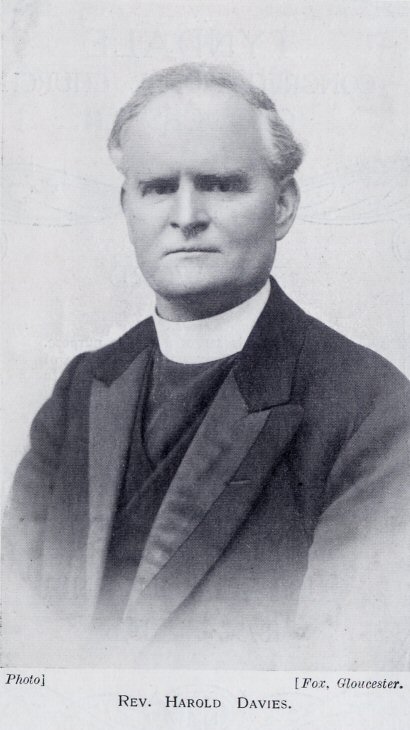 2 |
||||||||||||||||||||||||||
PROGRAMME
3 |
||||||||||||||||||||||||||
4 |
||||||||||||||||||||||||||
HISTORY OF THE CHURCHMOUNTAIN climbers sometimes pause in their upward course, to survey the way they have travelled. Then, encouraged and refreshed, they face cheerfully the greater heights beyond. We have reached a like place in our history as a Church at Tyndale. We desire in "Looking Backward", to find strength and inspiration to "Go Forward". THE DAWN.
The dawn in nature is a time of half-lights. So it is with the dawn of Tyndale's history. But there are two figures that stand out boldly in the daybreak, namely, Mr. Hurd, of Berkeley, and Mr. Benjamin William Cooke, of Painswick - laymen both. They blazed the forest and made the road, and will for ever stand as pioneers of the dawn. MR. HURD - THE MAN OF BERKELEY.
In the year 1871, the Church at Southgate Street, through its minister, Rev. J. P. Allen, M.A., and its officers, sent an invitation to a Mr. Hurd, of Berkeley, to come to Gloucester to open a mission in the rapidly developing Barton Ward. The Church had received a vision of missionary adventure and had heard a cry from the end of the City, "Come over and help us!" Mr. Hurd, having responded to the call, a room for holding services was secured in Barton Street, on premises owned by the late John Turner, a shoeing Smith. The "Man of Berkeley" was evidently a man of faith, for, according to an entry in his account book, bearing the date of August 7th, 1871, he paid a visit to Rev. J. Morton Brown, LL.D., of Cheltenham, relative to the purchase of a site in Barton Street, for a chapel. The expense of this visit was eighteenpence. Truly great doors hang on small hinges. This was the egg out of which was hatched the nightingale's song. Mr. Hurd's work came to a sudden end, the cause of which is wrapped in obscurity. But not before the necessary steps had been taken for the purchase of a plot of land for a future edifice. Then he merges into the mists. MR. B. W. COOKE - A PAINSWICK WORTHY.
His companion, Mr. B.W. Cooke, is a more commanding figure and stands out more clearly. He was permitted, in the providence of God, not only to work in the dawn, but to march far into the day. This sturdy man is a romantic and heroic figure. I want you to take a good look at him in the year 1871, as he comes down the Cotswolds on [cont'd] 5 |
||||||||||||||||||||||||||
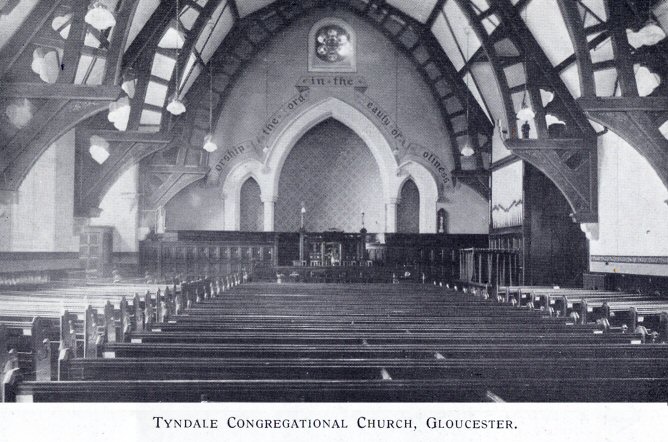 [page 6] |
||||||||||||||||||||||||||
|
his way to Gloucester market. He is worth looking at, for he is every
inch a man, as hardy in body and spirit as his native hills, and with
convictions as unshakable as the Painswick oaks. He comes of
true Puritan stock, being a
With Mr. Cooke thinking and acting were almost simultaneous. He at once consulted with the minister and Church at Southgate Street, with Mr. Hurd's invitation as a result. Soon after this, Mr. Cooke was one evening presiding over a meeting at Painswick, when a message from Mr. Hurd was handed up to him, which read, "Will you be responsible for the purchase of the land in Barton Street? " His answer was an immediate "Yes"! The amount involved was £314. But the Church at Southgate Street generously came to his aid and mortgaged [cont'd] 7 |
||||||||||||||||||||||||||
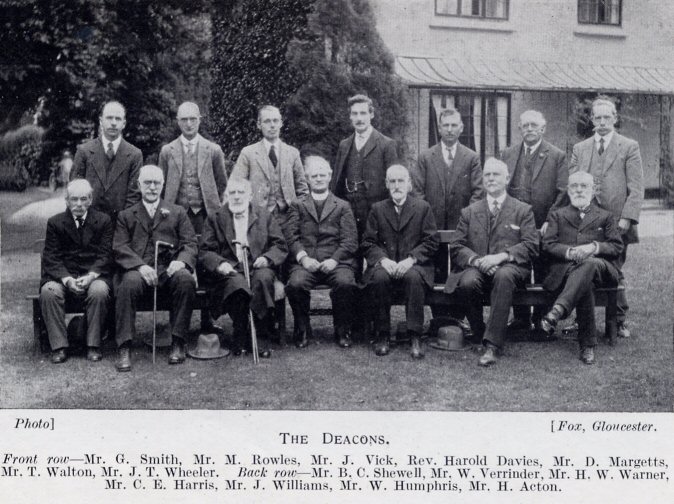 Front row - Mr. G. Smith, Mr. M. Rowles, Mr. J. Vick, Rev. Harold Davies, Mr. D. Margetts, Mr. T. Walton, Mr. J. T. Wheeler. Back row - Mr. B, C. Shewell, Mr. W. Verrinder, Mr. H. W. Warner, Mr. C. E. Harris, Mr. J. Williams, Mr. W. Humphris, Mr. H. Acton. [page 8] |
||||||||||||||||||||||||||
|
their Glebe in Horton Road to provide the purchase money. A former historian has called Benjamin William Cooke "The Grand Old Man of Gloucestershire Congregationalism"; and well he deserves the title. To him and Mr. Hurd belong the-credit of writing the "Genesis" of Tyndale's history and of transforming the place where the fruits of earth grew, into a place for the cultivation of the fruits of the Spirit. "Being dead they yet speak". In 1873, the County Association began to take an interest in the work, so that it is evident that Mr. Hurd's work was not fruitless. In 1874 the Executive Committee of the County Union accepted responsibility for the forward movement work in the Barton Ward. In the first week of May 1874, they invited Rev. John Bennetts to assume charge. At this time the name "Tyndale Chapel" appears for the first time in the Southgate Minute Book. A room was procured over the newly erected Co-operative Store in Stratton Road, the scattered friends were once more gathered together and worship commenced. Meanwhile, the County Executive Committee had appointed Sir S.S. Marling, Stroud ; Rev. J P. Allen, Gloucester; Rev. E. J. Hartland, Bristol (Secretary) and Dr. R.W. Batten, J.P. (Treasurer) to overlook the work, prepare a scheme for chapel building and obtain the necessary funds. They entered into their task with faith and enthusiasm. Mr. Tait, of Leicester, was instructed to prepare plans for the proposed Tyndale Chapel. When these were ready the contract for building was given to Mr. Meredith, of Gloucester. A new church is not born without labour. The next step was the preparation of the Trust Deed. This was signed on August 8th, 1874, by twenty-one trustees. The Trust Deed, which is our Charter, is an interesting document. It provides for the Congregational form of government and doctrine. A notable omission is "The five limbs of Calvinism", which is usually found in many old trust deeds. This omission indicates that those who drew it up were broad-minded and far-seeing men, who did not desire to shackle future ministers to the doctrinal and creedal standards of the time, but believed with the famous "Father of, Congregationalism", Robinson, that "God hath yet more light and truth to break forth from His Word". OUR HONOURED NAME.
The Chapel was given the name of Tyndale in no casual or accidental way. It was built as a memorial to William Tyndale, the translator of the Bible into the English language. There is ample proof of this. In the report of the laying of the Foundation Stone of the Chapel, in The Gloucester Journal for May 11th, 1875 (a copy of which is preserved in the Public Library and placed at my disposal through the kindness of Mr. Roland Austin), there are these words: "The new Congregational Church in Lower Barton Street, named Tyndale in commemoration of the martyred Bible translator, was opened for Divine Worship on Tuesday last". 9 |
||||||||||||||||||||||||||
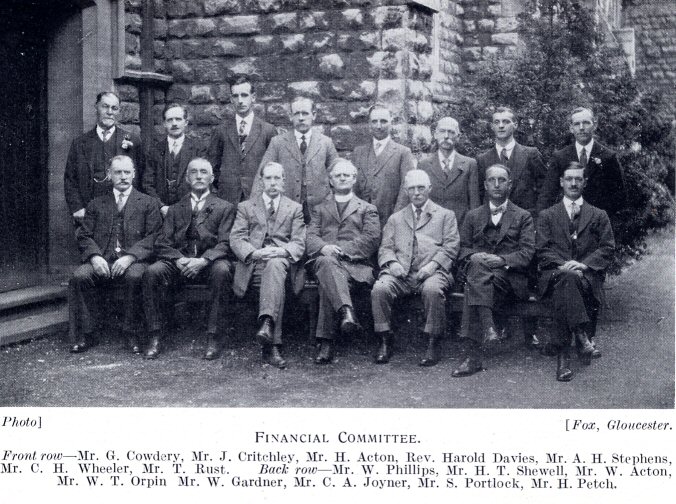 Front row - Mr. G. Cowdery, Mr. J. Critchley, Mr. H. Acton, Rev. Harold Davies, Mr. A. H. Stephens, Mr. C. H. Wheeler, Mr. T. Rust. Back row - Mr. W. Phillips, Mr. H. T. Shewell, Mr. W. Acton, Mr. W. T. Orpin Mr. W. Gardner, Mr. C. A. Joyner, Mr. S. Portlock, Mr. H. Petch. [page 10] |
||||||||||||||||||||||||||
|
In the same report it is stated that a bottle was placed under the Foundation Stone, which bore the words, "The Chapel will bear the name of Tyndale in commemoration of the great Reformer, William Tyndale, with whose fame as a divine and translator of the Scriptures, this, his native county of Gloucester, will be for ever associated". It would appear that Tyndale was intended to be a Memorial Church. There is an entry in the Southgate Minute Book, naming "Tyndale", before the erection of the building was begun. It seems to the author that there is no doubt at all about the naming of the Church. It is, in the strictest sense, a memorial to Gloucestershire's greatest son. The fact that Tyndale's quarter-centenary is being celebrated this year, makes our jubilee doubly interesting. STONE-LAYING AND OPENING CEREMONY.
The stone-laying ceremony was happily fixed to synchronise with the County Union meetings, which were held in Southgate Chapel in 1874. Thursday, October 29th, was the auspicious date. After luncheon at Southgate, the delegates and friends gathered at Barton Street to witness the laying of the foundation stone of the new chapel by Thomas Rowley Hill, Esq., M.P. for Worcester. After a hymn and prayer, Rev. E. J. Hartland read a copy of the document which had been placed in a bottle under the foundation stone, which was as follows:- "This chapel is erected with the sanction of the Congregational Union of Gloucester and Hereford and with the approval of the Church worshipping at Southgate Street in this city, to assist in supplying the spiritual needs of a population of between ten and twelve thousand persons, who have recently settled in the surrounding district. "The Church to be gathered here will be congregational in its polity, but its communion will be open to all who hold the essential doctrine of the gospel of Christ and whose lives are in harmony with its requirements. "The Chapel will bear the name of Tyndale, in commemoration of the great reformer, William Tyndale, with whose fame as a divine and translator of holy scriptures, this, his native county of Gloucester, will be for ever associated. "The foundation stone was laid with prayer and praise to the Father, Son and Holy Ghost, one God, on Thursday, 29th of October, 1874, by Thomas Rowley Hill, Esq., M.P. for Worcester. "The land on which the Chapel stands was purchased for £286 2s. 6d. The contract cost of the building to be erected was £2,432. Total, about £3,000. Glory to God in the highest and on earth peace among men of good pleasure." Amongst those who took part were Dr. Brown, Revs. V. Price and F. Hastings and Mr. Samuel Bowly, the renowned temperance advocate. 11 |
||||||||||||||||||||||||||
|
By the following August the work was approaching completion, and the
formal opening was fixed for September 7th, 1875. History says that
the day "opened bright and clear"; but not less bright were the hopes
of all those who were interested in the great project. The city that
day became the Mecca of Congregationalists, and they poured in from
Large contributions had been made towards the cost of the Chapel, as can be seen from the following list:- Southgate Chapel, £200; The Chapel Building Society, £200; Mr. William Sommerville, £1,000 and £75 per annum, being half the minister's stipend; S S. Marling, M.P., £200 ; S. Morley, M.P., £200; J. Bennington Mills, £100; The Coward Trustees, £50; B.W. Cooke, £25; H. Wilmot, £25; Joshua Wilson, £25; H.O. Wills, £21 ; W.P. Price, £20; C.J. Monk, M.P., £21 ; T.R. Hill, £20; G. Hadfield, £20 ; J. Cunliffe, £20 ; H. Wright, £10; C. Jupe, £10; J. Kemp Welch, £10; J.V. Sommerville, £10; I. Slater, £10 ; R.W. Batten, £10; J. Ware, £10; W.K. Wait, M.P., £10; Mrs. Hyett, £10; Sums under £10, £217 11s. 6d. The Building Committee gave another * Some of the above may be ministers. The history is a little obscure at this point. 12 |
||||||||||||||||||||||||||
|
£100 and sundry further gifts amounted to £54 10s.; whilst the collections on the day of opening amounted to £52: on that day Mr. W. Sommerville promised another £100. THE DAY
had now fully dawned. The Chapel was built and services commenced under the most favourable auspices; but the Church had yet to be gathered and formed. On September 19th, 1875, we have the first baptisms recorded, two boys, the first on the register being Frank Hugh, the son of Mr. Henry Thomas, and the other Henry Charles, son of Mr. John Grace; the third entry being that of Ada May, daughter of Mr. William Shewell. The Chapel was registered as a "Place of Worship" on October 1st. Early in 1876 the Church was formed by Rev. J.P. Allen, Dr. Brown and the Pastor of Wotton-under-Edge Church. After each of the members had received the right hand of fellowship into the Church, the ordinance of the Lord's Supper was observed. Amongst those received into fellowship on this occasion were the following: Rev. John Bennetts (Pastor), Sophia Jones (the Pastor's wife), both aged 39 years, Mr. and Mrs. Bridges, Mr. and Mrs. Dowrick, Mr. and Mrs. Mason, Mr. and Mrs. Hickling, Mr. and Mrs. Cotterel, Mr. and Mrs. Linton, Mr. and Mrs. Holbrook, Mr. J. Powell, and Mr. and Mrs. Hamblin. In 1877 a Monthly Magazine was started. A copy of this would now be interesting and useful; but, alas ! no copy can be found. On March 15th of the same year, the First Annual Church Meeting was held. At this time the membership of the Church was 61 persons, the number of scholars in the Sunday School 195, teachers 13, members of Men's Bible Class 38, Women's Bible Class 23. The income from the Weekly Offerings amounted to £66 16s. 8½d. and from other sources £11 16s. 2d., whilst £112 10s. 0d. was contributed by way of grant. The expenditure of the Church for the first year was £203 12s. 10½d., so that there was a deficit of £17 16s. 0d. On April 16th, 1877, Mr. Bennetts resigned the Pastorate. Shortly afterwards, he went to reside at Plymouth, where he died after a brief illness, on November 19th, 1891, at the early age of 54 years. Owing to the circumstances attendant upon the resignation of the minister, a dark and difficult time followed. The County Union was led to intervene and on Sunday, October 14th, 1877, the darkness fell and the following resolution was passed by the remaining members of the Church: "That the Church of Tyndale be, and is hereby, dissolved". But the darkness soon passed. Most churches have resurrections in their history. Friends from Tyndale and Southgate, firm in their faith, began to search out a man, God's man, who would take up the work and build anew. They knew that "The Great Head of the Church" would answer their prayers. "The man", who was "a hiding place from the tempest and a covert from the wind and the shadow of a rock in a weary land", unaware of the destiny God had in store for him, was at that time labouring quietly under the shadow of the hills at Malvern Link. 13 |
||||||||||||||||||||||||||
|
Carlyle is fond of saying that "the Crisis" always brings "the man". So it was in Tyndale's crisis. The Joint Committee from Tyndale and Southgate turned to the hills for help and invited REV. GEORGE TYPE
to take the services at Tyndale on Sunday, December 16th, 1877. After further trial, the Church unanimously carried a resolution, which reads: Having heard the Rev.
George Type, of Malvern Link,
we hereby solicit the Committee of Management to
request the Executive of the
County Union to invite him to
become Minister of this place
of worship". This was done
14 |
||||||||||||||||||||||||||
 [page 15] |
||||||||||||||||||||||||||
|
appointed. These were: Messrs. J. Vick, D. Margetts, J. Lewis, G. Gardner, W. Dewick, W. Lodge, and T. Walton. Later Messrs. J.W. Hopkins and J.H. Clarke were added. Thus the call to Mr. Type was proved to be of God. After six years'
strenuous service, he accepted a call to Moseley Road Church, Birmingham,
to the regret of the congregation at Tyndale. On leaving, he was presented
with an illuminated address, signed by the deacons and Finance
Committee, expressive of the love and esteem in which he was held by
the Church and congregation.
Thus ended the pastorate which
in the early days of Tyndale,
was just suited to lay a good
foundation for coming years.
REV. W. TUCKER.
The next in the succession to the ministry, the Rev. W. Tucker, was of a different order. His task, too, was somewhat different. The Church was large and prosperous, with many organisations. What was needed at this stage was consolidation and teaching. These needs were fully met in the new ministry. Lacking the free and popular style of his predecessor, he maintained the evangelical note. His was also a teaching ministry, whilst those who remember him, say that his prayers were wonderful. Many were added to the Church. During his pastorate the County Union Grant was dispensed with, being out of accord with his independent spirit. The Sale of Work became an annual event, and thanks to the good work of the Sewing Society was a great financial [cont'd] 16 |
||||||||||||||||||||||||||
|
success. The Chapel was renovated by Mr. Pickford at a cost of £130. The Mission Hall at Painswick Road was erected, through the generosity of Mr. Gaze, who presented the site and contributed £400. The Hall and the caretaker's cottage, when completed, were free of debt. The opening of the Hall took place on October 20th, 1887. A large manse, at the corner of Weston Road, was purchased for £800.
Spiritually, too, the work advanced. After three and a half years, Mr.
Tucker received a call to Gravesend and to the deep regret of all, was
accepted, on account of Mrs. Tucker's health. It was a short ministry,
The Church felt that there was need of God's guidance, and earnestly sought it; with the result that REV. JOHN COTTINGHAM,
of Haverhill, was brought to its notice. After trial, he was invited to take up the work. During his stay of six years good work was done. His preaching was solid and satisfying, but a little beyond the people to whom he preached. Yet he was greatly beloved, being a true shepherd in his care for the sick and poor. The Manse was. an ever-open door, whilst the children found in him a loving friend. He was faithful in labours, and made a worthy contribution to the history of Tyndale. He accepted a call to London, and then removed to South Africa, but after some years returned home to England to die. He and his faithful wife sleep together in Gloucester Cemetery, among many of those who were his spiritual children. The Master's word to this "faithful servant" was "Well done"! Very often level roads lead to mountains. Again God was preparing "a man" for Tyndale, whose ministry was to provide the most glorious chapter in its history. God's ways are wonderful. THE REV. W. J. PORTER,
at the time of Rev. Cottingham's departure, had already served two churches with conspicuous success. On leaving Bristol College, he settled at Whiteshill, Bristol, where he remained for nine years, doing a splendid work. Then he spent ten happy and fruitful years at Chalford, [cont'd] 17 |
||||||||||||||||||||||||||
|
building solidly, beloved by all who knew him. But God had yet a
greater work in store for him, for which all his life had been a preparation
and training. One Sabbath, that good friend of the Church and all the
churches, the late James Fielding, Esq., visited Chalford, and as was his
custom, went up to worship at the Congregational Church. He heard
18 |
||||||||||||||||||||||||||
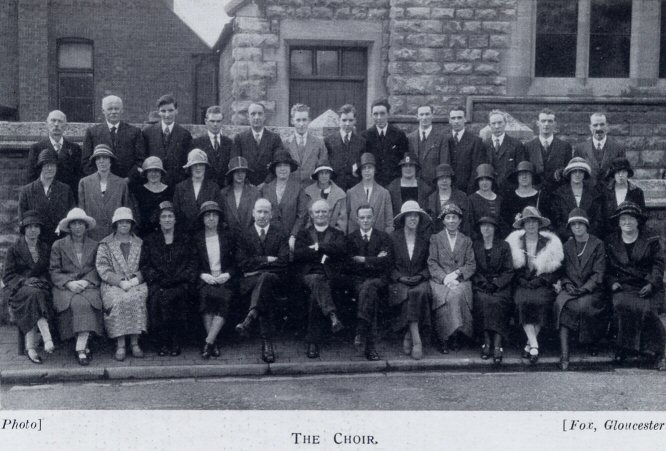 [page 19] |
||||||||||||||||||||||||||
|
the Church redecorated at a cost of over £100, both these being paid for. These achievements had their spring in the strong emphasis placed upon the spiritual aspects of the work. The centre of the Church's life was glowing with love for Jesus Christ and every part of the circumference received blessing. Each month saw additions to the Church-roll and during this ministry 555 were brought in. The Week-night and Communion Service were times of fellowship and large gatherings were the rule. Besides all this, Mr. Porter was a prominent figure in the life of the City and Denomination. He filled the following offices: Chairman of the Congregational Union of Gloucestershire and Herefordshire, President Gloucester Free Church Council, Member of Board of Guardians for over 20 years, Member of Executive Congregational County Union, Manager St. Michael's Schools, Chairman of the London Missionary Society Auxiliary. These multifarious duties, all well discharged, are explained by the term "method". The minister was able to do so much because he lived and worked by plan. In addition, he was a great Pastor. For many years his visits averaged over 800 per year. He held the pastorate over such a long period (20 years) that he was able to create his own atmosphere. He was consecrated, tactful, with a large fund of that uncommon commodity, common-sense. He kept his ministry fresh by constant reading and most of his sermons have a literary flavour. He was able to gather round him men and women of sterling ability and enthusiasm. His deacons, men like Messrs. John Vick, David Margetts, R. H. A. Clarke, Morton Rowles, Thos. Walton, C. E. Harris, A. Hart, H. Acton, J.T. Wheeler, A. Dutton, A. Camm, D.T. Lansley, account partly for the success attained. It should be said that Mrs. Porter's personality and work were no mean factors in the success achieved. When in July, 1916, Mr. Porter brought his ever-to-be-remembered ministry to an end at Tyndale, it was felt to have been all too short. He now serves in a wider ministry, in retirement, and the home of Mr. and Mrs. Porter is a scene of peace, affection and good will. The influence of this gracious and inspiring ministry will be felt in Tyndale for many years yet to come. REV. A. F. BLANDFORD, B.A.
There ensued an interval of sixteen months, during which time the Pulpit was occupied with supplies from various parts of the country, amongst whom was the Rev. A.F. Blandford, B.A., of Bitterne Park Congregational Church, Southampton, who, having very much impressed the Church and congregation on two successive Sundays, and excellent testimonials having been received, was recommended by the Deacons as a most suitable and promising minister for Tyndale Church. This was fully approved at a Church Meeting on October 17th, 1917, and Mr. Blandford was duly invited to become the Pastor. This was accepted and his ministry entered upon on Sunday, December 2nd, 1917. Being desirous of more scope and a wider field of service, Mr. Blandford came in the freshness and vigour of young manhood. Having given an outline of his proposed work of reconstruction, he suggested the organising of young people's societies. He set himself to [cont'd] 20 |
||||||||||||||||||||||||||
|
the task and drew around him a large circle of young folk. This was very essential, from the fact that, in common with other churches, the "Great War" had been depleting the church and many were the gaps created. Mr. Blandford entered into much correspondence with the "Boys at
These were difficult times, Mr. Blandford's ministry covering the closing days of the war and the first of The Peace. The word, "Camouflage" was beginning to wane, only to be followed with a ringing of the changes upon "Reconstruction and Production". After four weary years came the Armistice, and preparations were pushed forward to welcome home "The Boys", who were to share in solving the problems and utilising the opportunities of the New Era. Great was the delight of the Pastor in meeting with so many with whom he had corresponded so long. One of the outstanding events during Mr. Blandford's ministry was the entertaining of the County Union on April 11th, and 12th, 1921, to which a host of willing workers rallied. There were some 140 delegates and they spoke in high appreciation of the warm welcome and kindly hospitality they had received at the hands of the Tyndale friends Several of Southgate Church also assisted. The meetings were most successful and proved very inspiring. The Pastorate, however, was a short one; for after three years and nine months' service a call came from the Colonial Missionary Society [cont'd] 21 |
||||||||||||||||||||||||||
|
to undertake the Pastorate of North Street Congregational Church, Kingston, Jamaica. This appealed strongly to Mr. Blandford, and he accepted it. He preached his farewell sermon at Tyndale, on Sunday, September 11th, 1921; sailing with Mrs. Blandford and their three boy, on Tuesday, September 20th, with an expression of every good wish for their future success from all their friends. REV. HAROLD DAVIES.
The pulpit was thus rendered vacant for the sixth time and was occupied, from Sunday to Sunday, by excellent ministers from all parts of the country. The interregnum, however, proved of short duration - the shortest on record. On Sunday, January 8th, 1922, we received a visit from Rev. Harold Davies, of Blaina, Mon,, and all were desirous that he should come again. The date of the second visit was February 5th. The church was so impressed, that they called a Church Meeting for the following Wednesday evening. This was largely attended and unanimously decided to invite Mr. Davies to take over the pastorate at Tyndale. An unseen drawing power was at work, Mr. Davies having been much impressed by the Church and its situation, and given the consciousness that, with the co-operation of all and under the blessing of God, great things could be achieved for the Kingdom of God. In answer to our "Call", to the joy of the Church, there came an "Acceptance" and a promise to commence the new ministry on May 7th, 1922. The house difficulty at once faced us, the old Manse having been sold sometime previously. Prayer was made about the matter and on April 10th, 16 Howard Street was purchased and is now named "Tyndale Manse". On May 7th the new minister commenced his work. He came to us with a great reputation as an all-round man. In his pastorate at Cross Keys he had gathered a great congregation, his preaching having an attraction for men, chiefly because he addressed himself to their intellectual difficulties. The ordinary congregation often filled seats, aisles and pulpit. The School grew to be the largest in the county, and thousands of pounds were raised for various improvements. The Church more than doubled its membership. The same was true at Blaina. Up to the end, the Church was crowded and the membership doubled, whilst the last bit of work accomplished was the installation of an organ, costing £1,000, which was paid for. One of our ministers' most valued possessions is a gold watch, presented to him by "outsiders", i.e., people who never entered his Church. We were hoping and praying for blessing on the same ministry at Tyndale. He had been greatly blessed, too, in his home life, past and present. His father had been a well-known minister in Wales for over 50 years, whilst his brother had spent a few years, fruitful of promise in the same calling, but had died from after-effects of the war. The new ministry was thus bright with promise. In quick succession came "The Reception" on May 11th, and Induction Services on June 8th, conducted by Rev. Lincoln Jones, B.A., B.D. (Moderator), supported by Revs. F. Surman (a College friend) and J. Peill Cooper, Southgate, and other ministers. The new minister threw himself heart and soul into the work. His manly Christianity and optimism at once made its impression. The [cont'd] 22 |
||||||||||||||||||||||||||
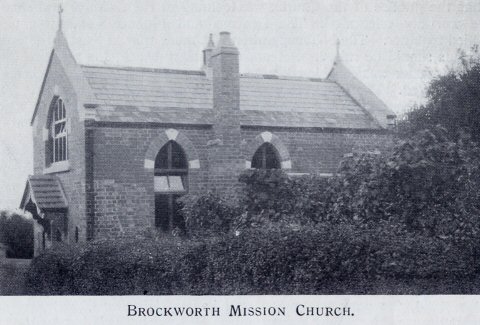 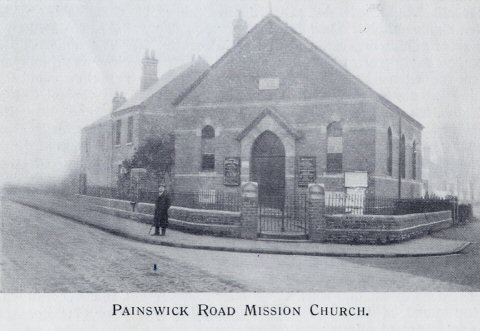 [page 23] |
||||||||||||||||||||||||||
|
congregation grew, the increase of men being specially notable. Many of these have since been drawn into the service of the Church. All the activities of the Church seemed to spring into new life. In less than twelve months Mr. Davies had found his bearings and also understood that the jubilee of the Church was looming in the distance and should be worthily celebrated. The Deacons and Finance Committee were called together. The bold suggestion was made that at least a thousand pounds should be raised. After a momentary shock, the practical side of the matter was considered, with the result that a "Jubilee Scheme" was evolved. The Committee were unanimous and enthusiastic. The Church received it in the same spirit. Promises of support were asked for in the form of a subscription. So hearty was the response, that on May 16th the first contract was given out - that of exterior repairs - which was duly carried through. As the funds came in, further work was done. A "burning question" at Tyndale for many years had been the system of heating the premises. The gas system was both wasteful and ineffective. So a hot water system was adopted, with radiators for Church and School, and a new underground heating chamber. This "consumed" £450. The apparatus was first used on October 1923, and has proved most effective. The Church now had "warmed up" and the electric lighting of the premises was embarked upon. The School and classrooms were done by voluntary labour. On September 14th, 1924, the new light was "switched on" in the Church by our senior deacon, Mr. David Margetts, and all saw the "glaring contrast" of the old and new illuminations. At this time a host of workers were as busy as bees behind the scenes, preparing for "The Jubilee Bazaar" This was held on November 26th, and 27th and put all previous records into total eclipse by the result, viz., £320. Our friends at Painswick Road Mission also organised a sale with most gratifying results. £56 was raised, and, as if not satisfied, they are, as we write, in the throes of a similar effort. Then the Primary School was taken in hand by a body of volunteers, who restored and decorated it. The same body of workers also decorated and renovated the main schoolroom and reorganised the kitchen; so that everything is now in first-class condition. The next matter dealt with under the "Scheme" was that of Church Renovation (Interior). The contract was duly placed on July 8th, 1925. During the month of August, those who visited the Church could see a transformation being effected, and on Sunday, September 6th, it was re-opened. The decoration now is simple, restful and effective. All this work has entailed tremendous labour, and its success is only explained by faith and co-operation. The Deacons and Committee have been hardworking and faithful, and have been supported by the Church and congregation in all their efforts. To bring the scheme to an end, there yet remain two pieces of work, viz., to make our contribution of £100 to "The Forward Movement", and also (by way of War Memorial) to improve our organ. These things, by God's help, we hope yet to accomplish, and when the Jubilee comes round, to usher it in with "the sound of trumpets" - with jubilation and triumph. For this special series of efforts [cont'd] 24 |
||||||||||||||||||||||||||
|
MR. A. H. STEPHENS
has proved himself a model Treasurer, always carrying about him (in addition to his receipt book) that cheery optimism, which is a necessary ingredient of success. All this is but the reflection of something deeper in the life of the
Church - of love to the Living Lord and faith in His Presence. So
that these activities and successes reveal the very centre, around which
they turn, the preaching and worship, for which the Church exists. The
preaching, whilst modern in form, has always had the "True
Foundation", and Christ has been revealed and many have been the
testimonies given to the helpfulness and power of the
MR. H. ACTON,
who, from his youth has been a pen-man of various societies. Mr. Acton's worth will be realised mare and more as the years pass, because his monument will be the Church Minute Books. No future historian will have any difficulty. The present history is being carefully preserved by the secretary. May he be spared to Tyndale for many years is our earnest prayer. Then what would we do without a Treasurer? Here again Tyndale is highly blessed; for in [cont'd] 25 |
||||||||||||||||||||||||||
|
MR. C.H. WHEELER
"Treasurership" touches all ideal meanings. He is no mere "accountant",
though his Church Account Books, with their cleanliness and
neatness of entry would, I believe, take first place in an inspection of
Treasurer's Books. Nor is he a mere "official", though scrupulous in
the discharge of his duties; for is he not Captain of Tyndale Cricket
26 |
||||||||||||||||||||||||||
|
pleading for the outpouring of His Holy Spirit upon their hearts and the Church. These, though so various, are all true ministries in "the fellowship of the saints". OUR MISSIONS.
The largest is that at Painswick Road. It seats 200 persons. Thirty-eight years of good work has been put in there and many have found The Saviour within its walls. The work commenced in services held in the home of our deacon, Mr. T. Walton and his sainted wife. The two distinctive features at the moment are (1) Its Sunday School. This is in a healthy condition under Mr. J. Williams and a faithful staff of teachers. (2) The Mothers' Meeting. About 50 mothers meet week by week for a Gospel Talk and Hymn singing, and find the meetings helpful. The President is Mrs. Dix, with Mrs. D. Nind as Secretary. As we think of the work in this rapidly developing neighbourhood, we visualise the day when there will be a fully organised Church and the usefulness of the work greatly expanded. Messrs. W. Humphris and J. Williams are Deacons working at this Mission. Messrs. W.C. Matthews, T. Chatwin and others worked hard for many years. Then there is the little Church at Brockworth. This nestles under the brow of Cooper's Hill, and was opened in 1899, through Mr. B.W. Cooke, of Painswick, who occupies such a prominent place in Tyndale's history. It accommodates 110 persons. Unlike its "little sister" at Painswick Road, it has no great population to draw upon. Notwithstanding, a goodly number of friends gather there, and in summer time the attendance is good. The services, as at Painswick Road, are conducted by Lay Preachers. For over 20 years Mr. William Bishop has been secretary, but of late infirmities and old age have laid hold upon him, and he has been assisted by Mr. G. J. Smart. The annual visit of their minister from Tyndale to the Anniversary and Harvest Festival, accompanied by Tyndale Choir, is quite the event of the year at Brockworth, and is a source of mutual happiness and edification. A VISION OF THE FUTURE.
All this is seen as we take a retrospective view of the past 50 years. We know our vision is defective and the way is long. But we are consoled by the thought, that no man can tell all that ties along the road of the years. Sometimes, when I sit in the Church, with its sacred memories and hallowed associations, the vision is clarified and I see a multitude of redeemed men and women standing before God, who once toiled in His service in the Church and enter into their joy which they found through sacrifice. Their names are upon no "Roll of Honour", but they "are written in Heaven". Then I am led to pray, "O God, to us may grace be given, to follow in their train". They call us to "paths unknown". They point to the shining heights of character and service still untrod. From the past, we turn our eyes to the summit, where our Lord summons us and sing to our hearts:-
27 |
||||||||||||||||||||||||||
TYNDALE CHURCHMINISTER.REV. HAROLD DAVIES. SECRETARY. MR. H. ACTON, 14, Sidney Street. TREASURER. MR. C. H. WHEELER, The Old Manse, Falkner Street. DEACONS. Messrs. D. Margetts, M. Rowles, J. Vick, T. Walton, J. T. Wheeler, G. Smith, W. Verrinder, H. Acton, B. C. Shewell, C. E. Harris, H.W. Warner, H. Petch, J. Williams and W. Humphris. DOORKEEPERS. Messrs. J. T. Wheeler and W. Verrinder, to whom applications for sittings should be made. MEMBERS OF CHURCH COMMITTEE. Messrs. W.T. Orpin, T. Rust, R. Shaw, A.H. Stephens, C.A. Joyner, W. Acton, W. Gardner, J. Williams, W. Phillips, G. Cowdery, J. Critchley, S. Portlock, together with the Deacons and other Officers of the Church. AUDITORS. Messrs. H.T. Shewell and R. Shaw. PAINSWICK ROAD MISSION HALL. Secretary - Mr. J. Williams. Treasurer - Mr. Humphris. Organist - Mr. Chatwin. Sunday School Sec. - Mr. C. Williams. Mothers' Meeting Supt. - Mrs. Dix. Mothers' Meeting Sec. - Mrs. Nind. BROCKWORTH. Secretary - Mr. W. Bishop. THE CHOIR. Secretary - Miss A. Dobbs. Registrar - Miss M.L. Gardner. Financial Sec. - Mrs. H.T. Shewell. Treasurer - Mr. B. Trustam. Conductor - Mr. B.C. Shewell. Organist - Mr. Reginald Shaw, A.L.C.M. Librarian - Mr. S. Portlock. Wednesday Service Organist - Miss P. Gardner. SUNDAY SCHOOL. Superintendent - Mr. B.C. Shewell. Secretary - Mr. W. Acton. Assistant Secretaries - Mr. Edgar Wheeler and Miss Doris Taylor. Primary Leader - Miss Grace Taylor. Accompanist - Miss A. Dobbs. BIBLE CLASS. Leader - Mr. W.J.H. Carter. Secretary - Mr. A. Gardner. Treasurer - Miss Gwen Taylor. YOUNG PEOPLE'S LEAGUE. Secretary - Miss A. Dobbs. Treasurer - Mr. W. Acton. LADIES' SEWING SOCIETY. President - Mrs. H. Davies. Secretary - Mrs. D. Nind. Treasurer - Miss C. Wheeler. Convener - Mrs. H. Petch. MISSIONARY WORKING PARTY. Leader - Mrs. W. Gardner. BAND OF HOPE. Superintendent - Mr. S. Portlock. Secretary - Miss B. Bracher. Accompanist - Miss W. Duggan. MAGAZINE. Secretary - Mr. E.A. Joyner, to whom all matter should be sent not later than 20th of month. LONDON MISSIONARY SOCIETY. Secretaries - Misses M.L. Gardner and G. Joyner. Treasurer - Mr. C.H. Wheeler. THE WATCHERS' BAND. Secretary - Miss G. Joyner. I.B.R.A. Secretary - Miss P. Gardner. CRICKET CLUB. Secretary - Mr. W. Gardner. Treasurer - Mr. W. Acton. Captain - Mr. C.H. Wheeler. Vice-Captain - Mr. S. Portlock. CARETAKERS. Mr. and Mrs. Barker, 2, Stratton Road. 28 | ||||||||||||||||||||||||||
[Transcription UK Copyright © 2011 Rosemary Lockie]
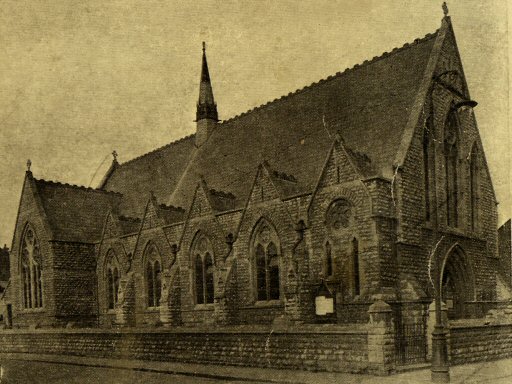
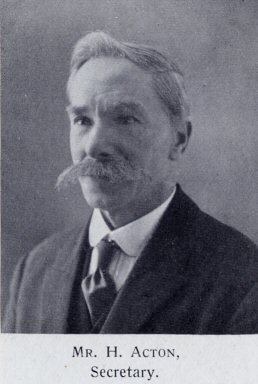
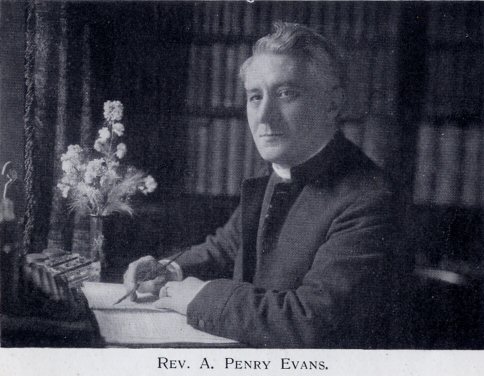
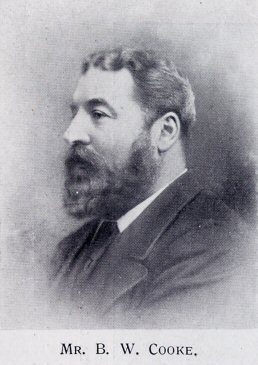 direct descendant of "Francis
Cooke", one of the gallant
band who sailed in the
Mayflower. The same love of
freedom that sent his ancestor
to America, sends this man here
and there planting Congregational
Churches, in which God
may be worshipped according
to the dictates of conscience.
The Cotswolds are his America
and he has already planted
churches at Painswick Edge,
Brockworth, Pitchcombe and
Slad. He is a Nonconformist
and Congregationalist to the
roots. He and his wife jog
along on their mountain ponies
through the fields and lanes,
on past Barnwood Church and
into the Painswick Road. To
the left of them, the old
"Rignum Fields", where the
army of King Charles encamped
during the siege of the city, have just been converted by the City Fathers
into a park, and here and there houses are springing up, indicating that
the city is extending its borders. A little nearer the city, they pass on
their left, a charming cherry orchard, with a brook murmuring through
it. On their right are the extensive meadows named Barley Close. In
years gone by, the nightingales made this orchard their headquarters.
But the grove of trees around the Vauxhall Tea Gardens (so named
after the famous London resort) have been recently cut down and the
song of the nightingales is hushed. But a sweeter song is soon to be
heard in the place - the song of salvation. As they pass, Mr. Cooke
turns to his wife at his side, and pointing to the orchard, says, "What
a fine site for a Congregational Church that would be". His wife voices
her agreement. So they pass on to do their business and the business
of "The King".
direct descendant of "Francis
Cooke", one of the gallant
band who sailed in the
Mayflower. The same love of
freedom that sent his ancestor
to America, sends this man here
and there planting Congregational
Churches, in which God
may be worshipped according
to the dictates of conscience.
The Cotswolds are his America
and he has already planted
churches at Painswick Edge,
Brockworth, Pitchcombe and
Slad. He is a Nonconformist
and Congregationalist to the
roots. He and his wife jog
along on their mountain ponies
through the fields and lanes,
on past Barnwood Church and
into the Painswick Road. To
the left of them, the old
"Rignum Fields", where the
army of King Charles encamped
during the siege of the city, have just been converted by the City Fathers
into a park, and here and there houses are springing up, indicating that
the city is extending its borders. A little nearer the city, they pass on
their left, a charming cherry orchard, with a brook murmuring through
it. On their right are the extensive meadows named Barley Close. In
years gone by, the nightingales made this orchard their headquarters.
But the grove of trees around the Vauxhall Tea Gardens (so named
after the famous London resort) have been recently cut down and the
song of the nightingales is hushed. But a sweeter song is soon to be
heard in the place - the song of salvation. As they pass, Mr. Cooke
turns to his wife at his side, and pointing to the orchard, says, "What
a fine site for a Congregational Church that would be". His wife voices
her agreement. So they pass on to do their business and the business
of "The King". Cheltenham, Stroud, Cirencester, the Forest of Dean and Bristol; for
had not some of the "Great Lights" of the denomination promised to
shed their radiance upon the event? Among these were the famous
Welshman, The Poet Preacher, Rev. Thomas Jones, at one time Browning's
minister, and Dr. R.W. Dale, of Birmingham, two names to conjure
with at that time. They both preached eloquent and instructive
sermons, a luncheon was held
and the promise of the
historic gathering was more
than realised. Amongst those
present were the Mayor of the
City (Thomas Robinson, Esq.),
Revs. E. J. Hartland (Secretary
of the Union), Dr. Brown
(Cheltenham), J. P. Allen,
John Bloomfield, J. Hunt and
J. Ramsden (Gloucester),
Messrs. J. Park (Stroud),
Stringer (Newnham), Reece
(Rodborough), Jacobs (Ebley),
Griffiths (Cinderford), Waters
(Chalford), Barwell (Cheltenham), Captain Goold and Mrs.
Ware (Newnham), J. Creese and
W. Cole (Cirencester), W. Sommerville (Bitton), Dr. Batten,
Rev. J. Bennetts (Pastor), and
Trevor Powell (Gloucester).*
Cheltenham, Stroud, Cirencester, the Forest of Dean and Bristol; for
had not some of the "Great Lights" of the denomination promised to
shed their radiance upon the event? Among these were the famous
Welshman, The Poet Preacher, Rev. Thomas Jones, at one time Browning's
minister, and Dr. R.W. Dale, of Birmingham, two names to conjure
with at that time. They both preached eloquent and instructive
sermons, a luncheon was held
and the promise of the
historic gathering was more
than realised. Amongst those
present were the Mayor of the
City (Thomas Robinson, Esq.),
Revs. E. J. Hartland (Secretary
of the Union), Dr. Brown
(Cheltenham), J. P. Allen,
John Bloomfield, J. Hunt and
J. Ramsden (Gloucester),
Messrs. J. Park (Stroud),
Stringer (Newnham), Reece
(Rodborough), Jacobs (Ebley),
Griffiths (Cinderford), Waters
(Chalford), Barwell (Cheltenham), Captain Goold and Mrs.
Ware (Newnham), J. Creese and
W. Cole (Cirencester), W. Sommerville (Bitton), Dr. Batten,
Rev. J. Bennetts (Pastor), and
Trevor Powell (Gloucester).*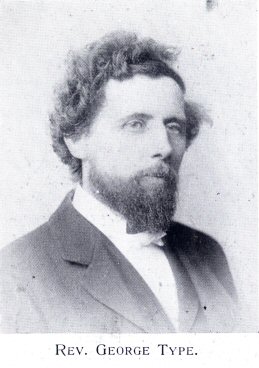 and Mr. Type began his Ministry on Sunday, April, 14th,
1878. Matters were in a
deplorable condition at this
time. There was a debt of
£821. The attendances at the
Sunday services were not more
than a score. The position
would have daunted any ordinary man. But the new Minister was quite out of the
ordinary. He set about his
task with faith and courage.
Almost immediately the tide
began to turn. The people
soon learned that a new star
had arisen in Tyndale's firmament, and came to see and hear. He
adopted new methods to meet the abnormal situation, advertising the
services in striking titles and assiduously visiting the homes of the people
around the Church. Soon it was felt that increased accommodation was
necessary. The partition, shutting off the transepts, was taken down,
pews substituted for chairs, the choir gallery and an organ erected. Still
the people came, and it was no rare thing to see the aisles filled and many
standing at the doors. A census gave the number present on a Sunday
evening at 1,050. Truly, a wonderful change in the situation! All the
institutions of the Church reacted in proportion. There was as yet no
Sunday School building, the classes being held in a space behind the walled-off
transepts. A movement was started to erect schoolrooms at a cost of
£1,200. The attendance leapt up from one to six hundred. An infant
schoolroom was also erected at a cost of £50. In 1879 the choir was
organised. One of that original choir remains a faithful chorister to
this day. The debt of £800 on the church was paid off, largely
through the labours of the Minister and the support of his flock.
The Church, too, during his ministry was re-formed and seven deacons
and Mr. Type began his Ministry on Sunday, April, 14th,
1878. Matters were in a
deplorable condition at this
time. There was a debt of
£821. The attendances at the
Sunday services were not more
than a score. The position
would have daunted any ordinary man. But the new Minister was quite out of the
ordinary. He set about his
task with faith and courage.
Almost immediately the tide
began to turn. The people
soon learned that a new star
had arisen in Tyndale's firmament, and came to see and hear. He
adopted new methods to meet the abnormal situation, advertising the
services in striking titles and assiduously visiting the homes of the people
around the Church. Soon it was felt that increased accommodation was
necessary. The partition, shutting off the transepts, was taken down,
pews substituted for chairs, the choir gallery and an organ erected. Still
the people came, and it was no rare thing to see the aisles filled and many
standing at the doors. A census gave the number present on a Sunday
evening at 1,050. Truly, a wonderful change in the situation! All the
institutions of the Church reacted in proportion. There was as yet no
Sunday School building, the classes being held in a space behind the walled-off
transepts. A movement was started to erect schoolrooms at a cost of
£1,200. The attendance leapt up from one to six hundred. An infant
schoolroom was also erected at a cost of £50. In 1879 the choir was
organised. One of that original choir remains a faithful chorister to
this day. The debt of £800 on the church was paid off, largely
through the labours of the Minister and the support of his flock.
The Church, too, during his ministry was re-formed and seven deacons 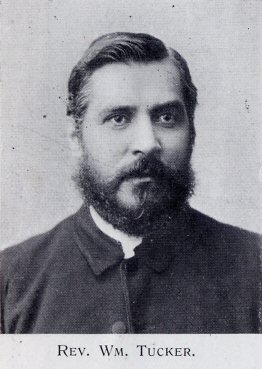 "Success" is elusive to define
and analyse. But there are
elements in this "man" of
God that stand out, such as his
unconventionality of matter
and manner, his stirring appeals to the affections, his deep
piety and evangelical motive
and his readiness "to be all
things to all men" in order to
win them. "Rescue" was an
outstanding word in his vocabulary, and he believed in "the
power of God unto salvation".
He was able, too, to gather
round his magnetic personality
a stalwart band of workers;
men like Mr. Thomas Shewell,
who worked amongst the infants for 28 years, Messrs. John
Grace, Morton Rowles, W.K. Collins, George Pickford, William Dewick
and Thomas Drinkwater (General Committee), with doorkeepers like Mr.
M. Rowles (40 years), and Mr. John Grace ; to say nothing of the host of
faithful sisters.
"Success" is elusive to define
and analyse. But there are
elements in this "man" of
God that stand out, such as his
unconventionality of matter
and manner, his stirring appeals to the affections, his deep
piety and evangelical motive
and his readiness "to be all
things to all men" in order to
win them. "Rescue" was an
outstanding word in his vocabulary, and he believed in "the
power of God unto salvation".
He was able, too, to gather
round his magnetic personality
a stalwart band of workers;
men like Mr. Thomas Shewell,
who worked amongst the infants for 28 years, Messrs. John
Grace, Morton Rowles, W.K. Collins, George Pickford, William Dewick
and Thomas Drinkwater (General Committee), with doorkeepers like Mr.
M. Rowles (40 years), and Mr. John Grace ; to say nothing of the host of
faithful sisters.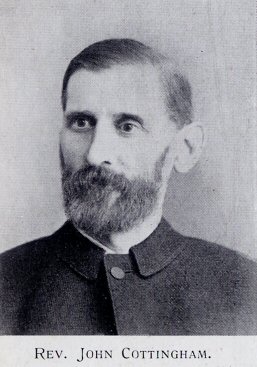 but crowded with achievement and lasting results.
but crowded with achievement and lasting results.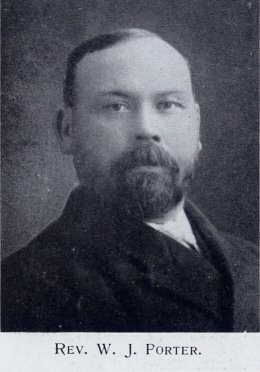 Mr. Porter and advised the friends at Tyndale to invite him, saying,
"He is just the man to suit you"! Those words bore fruit. The
Minister of Chalford received a unanimous call to the pastorate at Tyndale.
Notwithstanding the pain of parting from a devoted and prosperous
church, he felt the call was of God and entered upon what proved
to be the outstanding pastorate, of 20 years of great fruitfulness. He
commenced his ministry on the first Sunday of March, 1896. The
difficulty here is to do justice, in face of the accomplishments of the
Church during the period of Mr. Porter's ministry, and yet discriminate,
so as to keep the history within reasonable limits. To merely catalogue
them would be impossible in detail. The Christian Endeavour Society
was transformed into an instrument of power, in numbers and influence,
in the spiritual life of the City. This was recognised by the Union
making Mr. Porter President on three occasions. The Sunday School
became the largest in the City, with a fine staff of teachers and
consecrated superintendents in Mr. David Margetts and Mr. John Vick. The
minister was faithful to this branch of service and used it as an opportunity
to lead the young into the
service of Christ. For some
years he was the Secretary
of Gloucester Sunday School
Union. With all this, the
Mission Hall and its school
were not neglected and a
flourishing school was built
up there with the assistance
of Mr. W. C. Matthews,
Mr. T. Chatwin and Mr. J.
Williams. The same is true
of the work at Brockworth, with Mr.. Bishop acting
as secretary. A chapel
keeper's house was purchased
at 2, Stratton Road, for £270
and paid for. By the purchase
of this property the lighting of
the schoolroom was improved
by new windows. The
burden of church debt was
broken and the way for the
future made easy. A Pastor's
day in the vestry was
instituted and a Church Magazine, of which Mr. Porter was
Editor from the first number. This has appeared unbrokenly until
this day and is a distinctive feature of our work. A new
organ was placed in the Church at a cost of £430, and
Mr. Porter and advised the friends at Tyndale to invite him, saying,
"He is just the man to suit you"! Those words bore fruit. The
Minister of Chalford received a unanimous call to the pastorate at Tyndale.
Notwithstanding the pain of parting from a devoted and prosperous
church, he felt the call was of God and entered upon what proved
to be the outstanding pastorate, of 20 years of great fruitfulness. He
commenced his ministry on the first Sunday of March, 1896. The
difficulty here is to do justice, in face of the accomplishments of the
Church during the period of Mr. Porter's ministry, and yet discriminate,
so as to keep the history within reasonable limits. To merely catalogue
them would be impossible in detail. The Christian Endeavour Society
was transformed into an instrument of power, in numbers and influence,
in the spiritual life of the City. This was recognised by the Union
making Mr. Porter President on three occasions. The Sunday School
became the largest in the City, with a fine staff of teachers and
consecrated superintendents in Mr. David Margetts and Mr. John Vick. The
minister was faithful to this branch of service and used it as an opportunity
to lead the young into the
service of Christ. For some
years he was the Secretary
of Gloucester Sunday School
Union. With all this, the
Mission Hall and its school
were not neglected and a
flourishing school was built
up there with the assistance
of Mr. W. C. Matthews,
Mr. T. Chatwin and Mr. J.
Williams. The same is true
of the work at Brockworth, with Mr.. Bishop acting
as secretary. A chapel
keeper's house was purchased
at 2, Stratton Road, for £270
and paid for. By the purchase
of this property the lighting of
the schoolroom was improved
by new windows. The
burden of church debt was
broken and the way for the
future made easy. A Pastor's
day in the vestry was
instituted and a Church Magazine, of which Mr. Porter was
Editor from the first number. This has appeared unbrokenly until
this day and is a distinctive feature of our work. A new
organ was placed in the Church at a cost of £430, and  the Front". His letters and a Special Number of the December, 1917
Magazine, which contained a "Roll of Honour", consisting of nearly 80
names, were very highly appreciated by our absent ones, many of whom
replied with letters full of
interest and pathos. In his
early efforts, small chairs were
provided for the "Tiny Tots"
in the Primary Class. A
Children's Guild was opened
and a Literary Society was
formed. A Training Class for
the young was also established,
with good results; many of
its members coming into Church
Fellowship.
the Front". His letters and a Special Number of the December, 1917
Magazine, which contained a "Roll of Honour", consisting of nearly 80
names, were very highly appreciated by our absent ones, many of whom
replied with letters full of
interest and pathos. In his
early efforts, small chairs were
provided for the "Tiny Tots"
in the Primary Class. A
Children's Guild was opened
and a Literary Society was
formed. A Training Class for
the young was also established,
with good results; many of
its members coming into Church
Fellowship.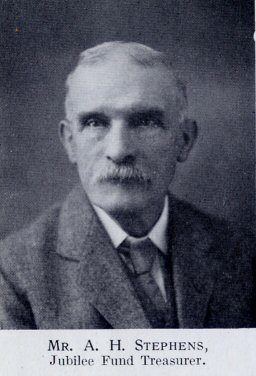 messages. The prayer and
fellowship of the Church are
always emphasised and large
numbers have confessed their
allegiance to the only Saviour.
The "social implications" of
the gospel are fearlessly proclaimed and "holiness" given
a big content. The young
people are carefully shepherded
and cared for. in "the fold".
Next to the minister in the
life of the Church come the
officers. No church could be
more fortunate in this respect
than ours. From the Deacons
to the humblest worker,
there is faithfulness and
consecration and a desire
in the aged saints to "train
on" the younger members. The
number of our workers will
be seen from the photographs
and the appendix. The Church has ever had good secretaries. Men like
Mr. R.H.A. Clarke and Mr. D.T. Lansley did a good day's work and passed
on to their reward, whilst Mr. A. Camm still lives. In the present, the
succession is worthily maintained by
messages. The prayer and
fellowship of the Church are
always emphasised and large
numbers have confessed their
allegiance to the only Saviour.
The "social implications" of
the gospel are fearlessly proclaimed and "holiness" given
a big content. The young
people are carefully shepherded
and cared for. in "the fold".
Next to the minister in the
life of the Church come the
officers. No church could be
more fortunate in this respect
than ours. From the Deacons
to the humblest worker,
there is faithfulness and
consecration and a desire
in the aged saints to "train
on" the younger members. The
number of our workers will
be seen from the photographs
and the appendix. The Church has ever had good secretaries. Men like
Mr. R.H.A. Clarke and Mr. D.T. Lansley did a good day's work and passed
on to their reward, whilst Mr. A. Camm still lives. In the present, the
succession is worthily maintained by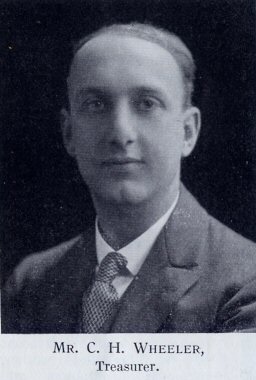 Club and Hon. Treasurer of
the Gloucester Auxiliary of
L.M.S.? What then is the
secret? A passionate love
for God's House, and consecrated zeal for the service
of the Kingdom. He loves
the work, because of a greater
love. With all due respect
to Treasurers and Secretaries,
and they deserve respect,
the writer believes that very
few churches are blessed with
such a pair as the present
Secretary and Treasurer. Their
books will be the despair of
future (may the time belong!)
officers. If I were asked
for some characteristics of
Tyndale I would give the
following: (1) Its homeliness.
(2) The excellence of its music.
All through the years music
has received attention and
the standard has been high,
as readers of the interesting notes on the choir, by Mr. J. Trustam, in
our Magazine, will know. Messrs. J. W. Hopkins, M.C. Bye and Jesse
Jones did their work well, whilst Miss Bridges and Messrs. F. Goatman
and F.C. Rowles ably assisted at the organ. A glance at our jubilee
Programme will show that the present choir, under the baton of Mr.
B.C. Shewell, with Mr. R. Shaw, A.L.C.M., at the organ, are adding
new lustre to the musical traditions of Tyndale. (3) The efficiency of
its Sunday School. Here again, excellent work is at present being done
under the wise and able superintendence of Mr. B. C. Shewell, with Mr.
W. Acton as Secretary - Miss Grace Taylor leading the Primary Class
and Mr. W. Carter the Senior Bible Class. Space forbids the mention
of the many societies at work in the Church. For details of these the
reader is referred to the appendix. There are so many ministries, some
silent, like those sweet messages to the sick in the flowers from the
Communion Table; some vocal, like preaching, teaching or singing ;
some active, like those of the caretakers, opening and shutting the doors
of the sanctuary, or doorkeepers attending to the comfort of the worshippers in many ways;
some passive, like waiting before God in silent
Club and Hon. Treasurer of
the Gloucester Auxiliary of
L.M.S.? What then is the
secret? A passionate love
for God's House, and consecrated zeal for the service
of the Kingdom. He loves
the work, because of a greater
love. With all due respect
to Treasurers and Secretaries,
and they deserve respect,
the writer believes that very
few churches are blessed with
such a pair as the present
Secretary and Treasurer. Their
books will be the despair of
future (may the time belong!)
officers. If I were asked
for some characteristics of
Tyndale I would give the
following: (1) Its homeliness.
(2) The excellence of its music.
All through the years music
has received attention and
the standard has been high,
as readers of the interesting notes on the choir, by Mr. J. Trustam, in
our Magazine, will know. Messrs. J. W. Hopkins, M.C. Bye and Jesse
Jones did their work well, whilst Miss Bridges and Messrs. F. Goatman
and F.C. Rowles ably assisted at the organ. A glance at our jubilee
Programme will show that the present choir, under the baton of Mr.
B.C. Shewell, with Mr. R. Shaw, A.L.C.M., at the organ, are adding
new lustre to the musical traditions of Tyndale. (3) The efficiency of
its Sunday School. Here again, excellent work is at present being done
under the wise and able superintendence of Mr. B. C. Shewell, with Mr.
W. Acton as Secretary - Miss Grace Taylor leading the Primary Class
and Mr. W. Carter the Senior Bible Class. Space forbids the mention
of the many societies at work in the Church. For details of these the
reader is referred to the appendix. There are so many ministries, some
silent, like those sweet messages to the sick in the flowers from the
Communion Table; some vocal, like preaching, teaching or singing ;
some active, like those of the caretakers, opening and shutting the doors
of the sanctuary, or doorkeepers attending to the comfort of the worshippers in many ways;
some passive, like waiting before God in silent